Legal blindness is a specific level of visual impairment that qualifies individuals for certain government benefits and protections. While many assume it means complete darkness, the reality is more complex and varies among those affected. Understanding legal blindness is crucial for accessing appropriate support services and medical care.
This comprehensive guide explores what it means to be legally blind, how it's diagnosed, and its impact on daily life. We'll also examine the various causes and available resources for those living with legal blindness.
Defining Legal Blindness
Legal blindness is determined by two main factors: visual acuity and visual field. In the United States, an individual is considered legally blind if their best-corrected visual acuity is 20/200 or worse in their better-seeing eye, or if their visual field is 20 degrees or less in the better-seeing eye.
To put this in perspective, someone with 20/200 vision must be 20 feet or closer to an object to see it with the same clarity as a person with normal vision would see from 200 feet away. This significant difference in visual capability impacts many aspects of daily living.
Measuring Visual Acuity
Eye care professionals use several methods to assess visual acuity and determine legal blindness:
- Snellen eye chart testing
- Visual field perimetry tests
- Contrast sensitivity evaluations
- Digital acuity testing systems
These comprehensive evaluations help healthcare providers make accurate diagnoses and recommend appropriate interventions or accommodations.
Common Causes of Legal Blindness
Several conditions can lead to legal blindness, including:
- Macular degeneration
- Diabetic retinopathy
- Glaucoma
- Retinitis pigmentosa
- Cataracts
- Traumatic injuries
- Genetic conditions
Early detection and treatment of these conditions can sometimes slow or prevent the progression to legal blindness, making regular eye examinations essential.
Living with Legal Blindness
Many legally blind individuals maintain some degree of useful vision. They often develop various strategies and use adaptive technologies to maintain independence:
- Screen readers and text-to-speech software
- Braille displays and materials
- White canes or guide dogs
- Magnification devices
- Smartphone accessibility features
These tools, combined with proper training and support, enable many legally blind individuals to work, study, and participate fully in daily activities.
Government Benefits and Support
Legal blindness qualification opens access to various assistance programs:
- Social Security Disability Insurance (SSDI)
- Supplemental Security Income (SSI)
- Tax deductions and credits
- Vocational rehabilitation services
- Special education services
- Transportation assistance
Documentation from a qualified eye care professional is typically required to access these benefits.
Frequently Asked Questions
What does it mean to be legally blind and how is it diagnosed?
Legal blindness is diagnosed when a person's best-corrected visual acuity is 20/200 or worse in their better-seeing eye, or their visual field is 20 degrees or less. Diagnosis involves comprehensive eye examinations by qualified eye care professionals using standardized testing methods.
What are the main causes of legal blindness?
The primary causes of legal blindness include age-related macular degeneration, diabetic retinopathy, glaucoma, cataracts, genetic conditions, and traumatic injuries. Some conditions develop gradually, while others may cause sudden vision loss.
How does legal blindness affect eligibility for government benefits?
Legal blindness qualification makes individuals eligible for various government assistance programs, including SSDI, SSI, tax benefits, and vocational rehabilitation services. Proper medical documentation is required to access these benefits.
Can people who are legally blind still see anything, or is it total darkness?
Most legally blind individuals retain some degree of vision. This can range from light perception to the ability to see shapes and colors, though not clearly enough for many daily tasks. Complete darkness is relatively rare among the legally blind population.
How is visual acuity measured to determine legal blindness?
Visual acuity is measured through standardized tests, primarily using the Snellen eye chart and visual field testing equipment. These tests assess both central vision sharpness and peripheral vision range to determine if someone meets the criteria for legal blindness.




